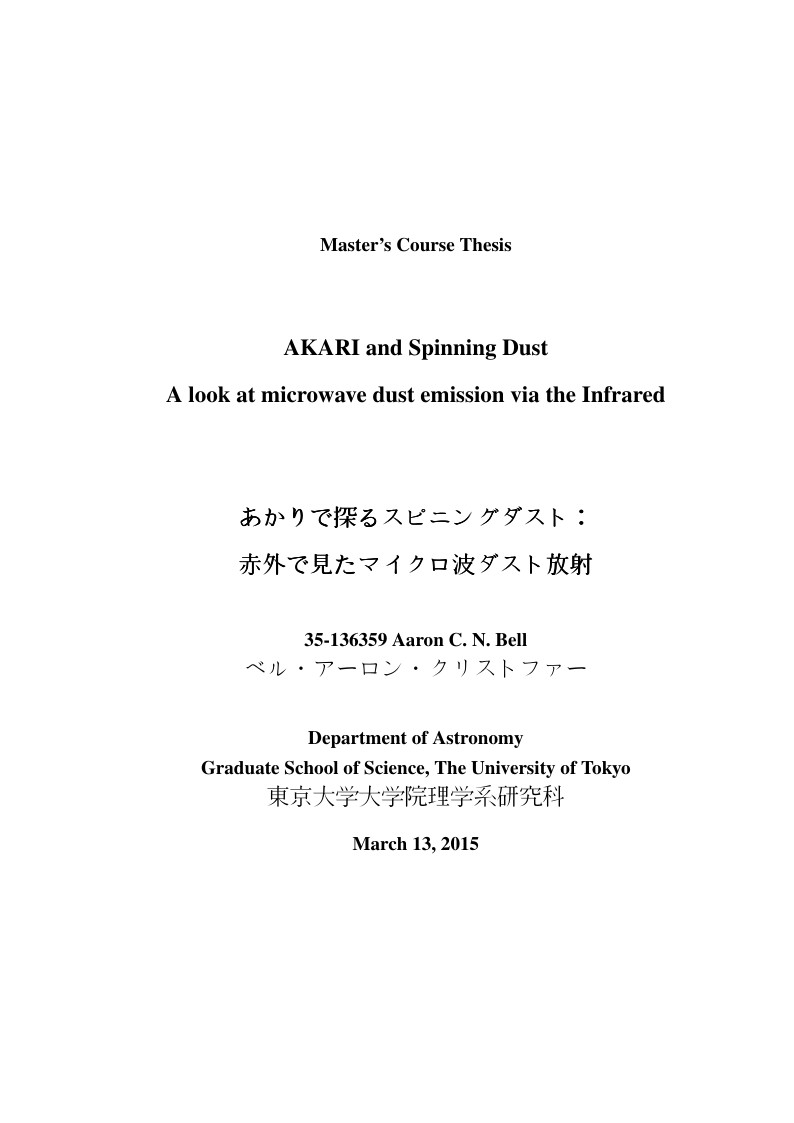
Master's Course Thesis
Author:
aaron c. bell
Last Updated:
11 years ago
License:
Other (as stated in the work)
Abstract:
AKARI and Spinning Dust: A look at microwave dust emission via the Infrared
Aaron C. Bell's Master's Course Thesis
ABSTRACT:
Rapidly spinning dust particles having a permanent electric dipole moment have been shown to be a likely carrier of the anomalous microwave emission (AME), a continuous excess of microwave flux in the 10 to 90 GHz range. Small grains, possibly polycyclic aromatic hydrocarbons (PAHs), are a leading suspect. In the absence of a definitive answer on the presence of PAHs or their role as an AME carrier, some predictions have been made as to the implications of spinning PAH emission. Due to the overlap between the CMB and the galactic foreground, this topic is requiring cosmologists to consider the ISM with more care. ISM astronomers are also needing to consider the contribution of cosmological radiation to large-scale dust investigations. We present data from AKARI/Infrared Camera (IRC) due to the effective PAH band coverage of its 9 micron survey to investigate their role within the 98 AME candidate regions identified by Planck Collaboration et al. (2014). We supplement AKARI data with the four Infrared Astronomical Satellite (IRAS) all-sky maps and complement with the Planck High Frequency Instrument (HFI) bands at 857 and 545 GHz to constrain the full dust thermal spectral energy distribution (SED). We sample the average spectral energy distributions (SEDs) all 98 regions. We utilize all 7 AKARI photometric bands, as well as the 4 IRAS bands and 2 HFI. We carry out a modified blackbody fitting, and estimate the optical depth of thermal dust at 250 micron, and compare this to AME parameters. We also show plots of each band's average intensity for all 98 regions vs. AME parameters. We find a positive trend between the optical depth and AME. In the band-by-band comparison the AKARI 9 micron intensity shows a weaker trend with AME. In general, the MIR correlates less strongly with AME than the FIR. The optical depth vs. AME trend improves slightly when looking only at significant AME regions. Scaling the IR intensities by the ISRF strength G0 does not improve the correlations. A slightly positive trend found previously among 10 AME regions vs. AME significance is revisited, using the larger sample of 98. However the trend does not hold up to the full data set. We cannot offer strong support of a spinning dust model. The results highlight the need for full dust SED modelling, and for a better understanding of the role that magnetic dipole emission from dust grains could play in producing the AME.

\begin
Discover why over 20 million people worldwide trust Overleaf with their work.